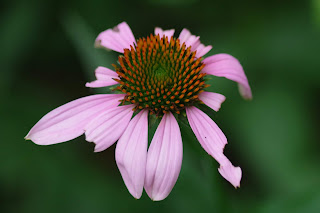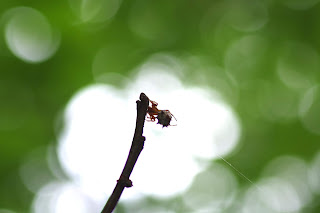Still when you have a patch of flowers that are attractive to bugs, the flowers tend to end up looking like this:
Note the hoverfly. I think it is the only one I saw today. There is also a spider in this picture, but don't tell the arachnophobes.
So, these flowers are very popular with pollinators, which is exactly what the flowers want, but they are also attractive to things that want to nibble on the petals instead of take some nectar in exchange for moving the pollen around.
And I found more of these today, pupal cases poking out of the center of the black-eyed Susans. I haven't seen any of these chrysalides that still have pupae in them, so I have developed a hypothesis about this. There have been caterpillars all over these flowers for weeks. I think the caterpillars are burrowing down into the flower head and chrysalizing inside them, and then in the process of eclosing, the pupal case works its way out of the flower, to be left behind when the moth emerges. I haven't seen it happen, but it could be true.
I suppose I can't at all complain about the wreck that the bugs make of my flowers went I plant them for the purpose of attracting the bugs.
Backyard Co-Bug of the Day #1:
The other day I said this would have been Backyard Bug of the Day if I had been able to get better pictures of it, so...
Backyard Co-Bugs of the Day #2:
I think I may have been wrong about the tiny caterpillars that were all over that milkweed leaf the other day. I said they were fall webworms, but I think they were actually milkweed tussock moths. I don't know where the rest of them went, but I found these two today on the plant where they hatched.
The heat wave is over, and the bugs and I are all pleased.
Other Bugs (in the order in which they uploaded, because I am tired):
Still waiting for these to hatch. I don't think the one on the left is gong to, though.
Flower fly. These were the most common bugs on the black-eyed Susans today.
Somewhat cooperative small wood satyr
Monarch butterfly egg. On the same plant with the one that just hatched three days ago. For the sake of this egg it is a good thing the other caterpillar has moved to another leaf. While it couldn't do so at its current size, larger caterpillars will eat eggs.
Three days since hatching...
This thorn mimic plant hopper was on a black-eyed Susan stem.
Grasshopper nymph
Cocoon
Robber fly
Assassin bug nymph or wheel bug nymph
Katydid nymph
Grasshopper nymph
The first cricket I have seen this year!
Assassin bug feeding on case bearing beetle larva. I guess that case wasn't much protection.
Ants on queen Anne's lace (or perhaps one of the flowers that looks like it–it doesn't have the red spot in the middle).
Bee and plume moth. What you can't see is the assassin bug nymph that has captured another plume moth among the flowers.
Could these be milkweed tussock moth caterpillars? They don't look like it, but they are feeding on milkweed, and could change quite a bit from one instar to another.
Aphids
I am pretty sure this is a nymph of the candy striped leaf hopper.
I found this, which is obviously an earlier instar of...
... this.
The baby stinkbugs are still hanging around their eggs. They were huddled together until I bumped the leaf and they scattered.
Fly
Lace bug with parasite
Side view of a plume moth. I don't think I've had this vantage point before.
Monarch butterfly
Arachnid Appreciation:
.
.
.
.
.
.
.
.
.
.
.
.
Mating pair of harvestmen, I think.
I think this is a spined micrathena. Its web stretches across the path, so I had to walk around it, and I feel like it owed me a better picture for my consideration.














































No comments:
Post a Comment